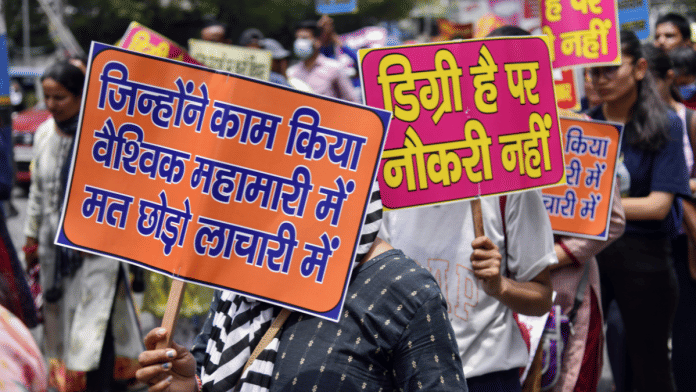Thank you dear subscribers, we are overwhelmed with your response.
Your Turn is a unique section from ThePrint featuring points of view from its subscribers. If you are a subscriber, have a point of view, please send it to us. If not, do subscribe here: https://theprint.in/subscribe/
In a modest apartment in Mumbai, 24-year-old Priya holds an engineering degree but delivers groceries on her scooter for ₹15,000 a month. In rural Punjab, Rajesh’s computer science diploma hangs on the wall while he tends to his family’s wheat fields. Down south in Kerala, management graduate Arjun serves tea at his uncle’s chai stall, his fluent English wasted on ordering supplies. In Chennai’s IT corridor, Meera’s biotechnology degree gathering dust as she works night shifts at a call centre. Kolkata’s Amit, armed with a commerce degree, drives an Uber through the city’s chaotic streets, while in Delhi’s Connaught Place, Rekha’s journalism qualification means little as she sells insurance policies door-to-door. Across India, 370 million young people — the world’s largest youth population—find themselves caught between soaring aspirations and shrinking opportunities.
While policymakers celebrate India’s demographic dividend, the mathematics tell a sobering story. With a youth unemployment rate of 15.3%, India wastes more young talent than entire countries possess. Yet paradoxically, industries desperately need workers. The disconnect isn’t about numbers — it’s about the gap between what youth learn and what economies need.
The Great Skill Mismatch
India’s National Youth Policy 2014 promised to transform young lives through education, employment and entrepreneurship. A decade later, the policy reads like fictional movie. Despite identifying critical sectors like IT, manufacturing, services, renewable energy—that could absorb millions of workers, the translation from classroom to workplace remains broken.
The irony is, India produces 1.5 million engineers annually, yet companies struggle to find job-ready candidates. Traditional education systems pump out graduates trained for yesterday’s economy meanwhile, millions of youth survive on family support, informal odd jobs, or government schemes offering temporary relief rather than permanent solutions.
A Global Epidemic
Among the world’s top five youth populations and their corresponding unemployment rate such as China’s 14.5% youth unemployment reflects structural problems despite massive vocational education investments. Indonesia’s 16% rate persists even amid aggressive digital skills programs. Only Nigeria (6.5%) and Pakistan (8%) show lower rates, but their economies remain heavily informal, masking widespread underemployment.
China’s response combines state intervention with private sector partnerships, rapidly expanding “dual education” programs. Indonesia focuses on local entrepreneurship. Pakistan emphasizes freelancing. Yet none have cracked the code completely.
The Hidden Costs of Wasted Potential
Every unemployed graduate represents lost tax revenue, reduced consumer spending and squandered innovation potential. When young minds aren’t productively engaged, societies face rising crime, social unrest and political instability.
More critically, unemployment destroys the demographic dividend that economists promised would propel India toward developed nation status. Instead of 370 million productive workers driving growth they become 370 million dependents straining resources.
Beyond Government Schemes
Political manifestos overflow with youth employment promises. The ruling coalition hands out appointment letters like festival tokens, while the principal opposition vows to enshrine a “Right to Employment”. State governments announce startup funds and skill centres. Yet these initiatives treat symptoms while ignoring root causes.
The real solutions demand systemic transformation. Education must pivot from degree-obsessed to skill-focused learning. Schools need career counselling from grade 8, not just before graduation. Curricula must align with industry needs, along with soft skills, communication and critical thinking as core subjects.
Industries bear equal responsibility. The obsession with “experienced candidates” for entry-level positions creates a paradox where youth can’t get experience without jobs and can’t get jobs without experience. Companies must invest in training rather than expecting plug-and-play workers.
The Entrepreneurship Imperative
Perhaps most importantly, India needs an entrepreneurial revolution. Self-employment and small business creation becomes essential. This requires access to credit, mentorship and failure-friendly ecosystems where young entrepreneurs can experiment without devastating consequences.
Countries like Estonia and Singapore transformed their economies by empowering young entrepreneurs. India’s “jugaad” culture and digital infrastructure provide similar foundations, but policy frameworks remain bureaucratic and risk-averse.
The Path Forward
The window for harnessing India’s demographic dividend is narrowing. Within two decades, this youth bulge will age and the opportunity will pass. The choice is stark: transform 370 million young lives into engines of prosperity, or watch them become anchors of economic stagnation.
Success requires coordination across education, industry and government. It demands honest acknowledgment that current approaches aren’t working. Most critically, it needs recognition that youth unemployment isn’t a problem to be managed — it’s potential energy waiting for the right catalyst to transform not just India, but the world.
This article reflects the author’s insights and interpretations and is intended to contribute to ongoing discussions in youth development. Individual stories are fictional composites based on documented unemployment trends; any resemblance to real persons is purely coincidental.
These pieces are being published as they have been received – they have not been edited/fact-checked by ThePrint.


